

Indian classical dance is a term used to define the ancient Hindu mystical dance forms. These dance forms have their origin in Natya sastra, an ancient Hindu scripture. Natya sastra was written by ancient scholar Bharat Muni. This is considered the first-ever compilation of various forms of dance. It can be traced back to 200BCE to 200AD. It has 36 chapters consisting of 6000 verses. Between the 12th century to 19th centuries, Sangeet Nataks were performed in India. Indian classical dance can be broadly defined in two sections one Tandav and another one Laya. Tandava contains movement and rhythm and Lasya contains grace, bhava and Rasa. There are eight major classical dance forms in India.
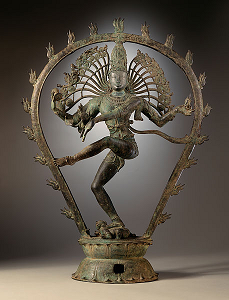
Chola bronze sculpture of Shiva as Nataraja, the Lord of Dance
Los Angeles County Museum of Art, Public domain, via Wikimedia Commons
Currently, the Sangeet Natak Akademi of India recognises eight classical dances originating from different Indian regions and they have their roots in Natya Shastra. Natya Shastra is a Sanskrit religious text on performing arts by sage Bharata Muni.
Bharatnatyam - This classical dance form originated from Tamil Nadu’s temples in Southern India. The roots of this dance lay in Natya Sastra.
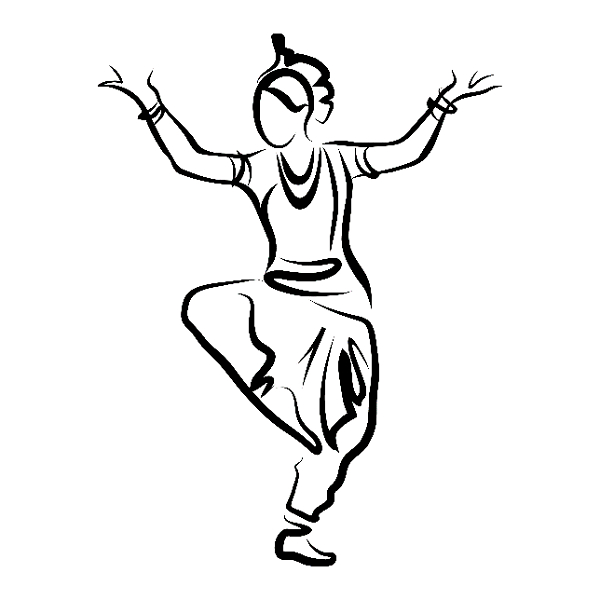
Bharatnatyam is believed to be the oldest classical dance form in India and is, therefore, often termed as the ‘mother’ of several other Indian dance forms.
The term has been derived from two Sanskrit words, ‘Bharata’ and ‘Natyam’. The term Bharata is a combination of ‘bha’ meaning feelings or ‘bhava’, ‘ra’ meaning melody or ‘raga’, and ‘ta’ meaning rhythm or ‘taal’.
It consists of extensive footwork, hand gestures and facial expressions.
Women in Bharatnatyam dawn a brightly coloured silk sari with a pleated cloth and then stitched in the front. The hair is tied in a bun and adorned with flowers. A beautiful belt compliments the sari at the waist and jewellery.
Men sport beautiful dhotis decorated with heavy embroidery and silks. Kathak - Kathak originated in Varanasi and developed during the historical Bhakti Movement.
Kathak was initially a dance form through which the poets and storytellers of ancient Northern India narrated historical stories. They were also known as ‘Kathakars’. Kathak is derived from the Sanskrit term ‘Katha’ meaning ‘story’.
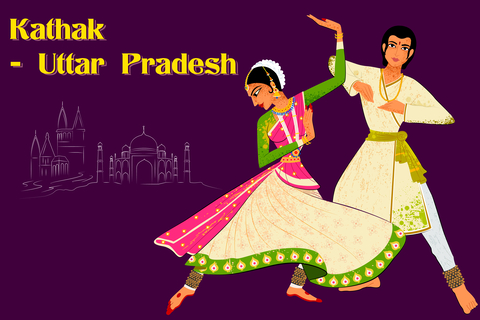
Kathak involves the narration of stories through rhythmic hand and foot movements accompanied by excellent expressions and eye movement.
Great Indian epics and stories from Indian mythology have been narrated through Kathak.
Women wear a bright sari and blouse or a lehenga-choli (long skirt) with a veil or the traditional Mughal angrakha accompanied by a churidar on the legs.
Men either wear a kurta churidar or a dhoti with a pleated cloth hanging from the waist.
Kathakali- It originated in the southern state of Kerala. It developed in the courts of Hindu kings.
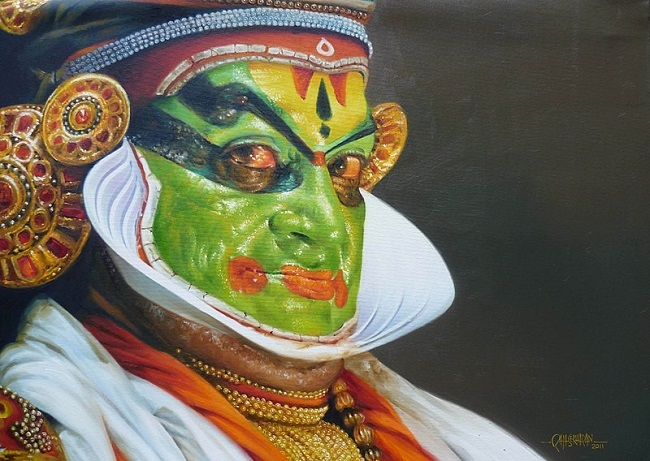
User:Rajasekharan Parameswaran, CC BY-SA 3.0
The term has been derived from two Sanskrit words- ‘Katha’ meaning a tale and ‘Kala’ meaning art.
Like other classical dances, Kathakali is also an art through which ancient tales are retold. It includes vivid expressions and rhythmic foot and hand gestures.
The costume and make-up of Kathakali are complex. It involves face painting, where a green face denotes a king or a noble, a red face denotes evil or Ravana and, a black face denotes forest dwellers. Yellow denotes monks.
The range of costumes includes ‘Sathwika’, ‘Kathi’, ‘Minukku’and, ‘Thatti’ for the upper part and the lower part rounded long white skirts for the men. The women wear a white sari coupled with red jackets and a headscarf.
Kuchipudi - Kuchipudi originated from Andhra Pradesh developed by travelling poets and storytellers.
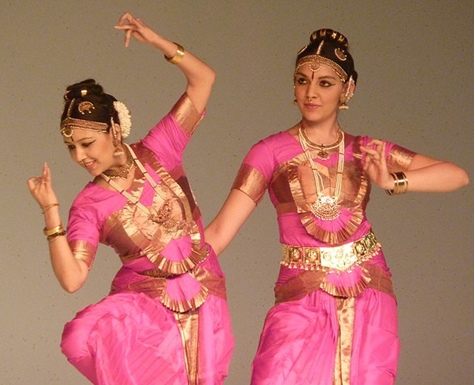
Erik Wilde from Berkeley, CA, USA, CC BY-SA 2.0
Kuchipudi developed as a dance form to praise Lord Krishna and Vaishnavism. It was traditionally performed only by men but not anymore.
It is characterised by expressive eyes, fluent hand and foot movements and a spirited narrative. It combines ‘Tandava’ (the masculine) and ‘Lasya’ (the feminine).
A Kuchipudi performance is executed on a brass plate. It requires both dancing and acting skills.
The Kuchipudi costume is similar to the Bharatnatyam costume where the women wear vibrant pleated saris with a belt and ornaments. Men wear a pleated dhoti.
Manipuri - Manipuri originated and developed in the northeastern state of Manipur.
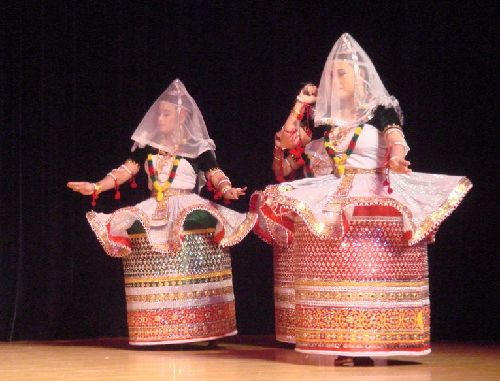
Matsukin, CC BY 2.0
Manipuri is noted for expressing through dance, Vaishnavism, Shaktism, and Shaivism themes. Through Manipuri, ‘Ras Lila’ or the love story between Radha and Lord Krishna is also portrayed.
Manipuri is simpler than other classical dances, with the women having light and graceful movements and the men having more powerful moves.
Women wear a velvet blouse and a cylindrical long, stiff skirt decorated with silk embroidery and a veil, men wear a pleated dhoti, kurta and a white turban.
Sattriya - Sattriya originated in Assam’s Monasteries.
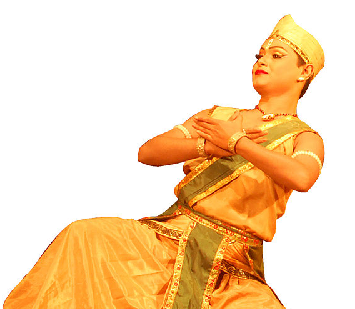
Dipjyotidipankarsattriya, CC BY-SA 3.0
Sattriya is a dance form that worships Lord Krishna and Vaishnavism.
Sattriya was an instrument to spread the teachings of Lord Krishna and traditionally women were not a part of Sattriya.
The monks who taught Sattriya found it inappropriate to dance with women and often women did the dance together. Later on, some skilled women were able to play the roles of men in Sattriya.
The male Sattriya costume consists of the dhoti, chadar and turban. The female costume comprises the ghuri, chadar and Kanchi.
Odissi - Odissi originated from Odisha.
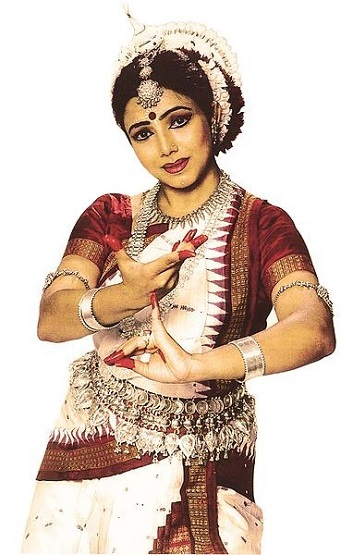
Subhojit roy, CC BY-SA 3.0
Odissi pays homage to religious texts, poems, and spiritualism through intricate hand gestures, foot movements and brilliant expressions.
Themes of Vaishnavism are portrayed through Odissi.
Women predominantly perform Odissi and the costume is a silk sari with pleats in between, similar to a Bharatnatyam costume. The sari has beautiful local handicraft work. Alta, a red dye is used to colouring the hands and feet of the dancer.
The men wear pleated dhotis with wrapping over one shoulder.
Mohiniyattam - Mohiniyattam evolved and developed in Kerala.
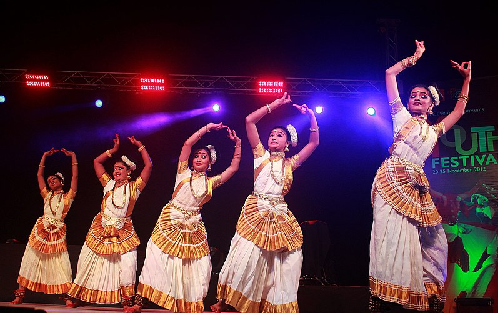
Sumita Roy Dutta, CC BY-SA 4.0
Women perform Mohiniyattam to praise and honour Lord Vishnu. It is derived from the name ‘Mohini’- a feminine form of Vishnu. It is also known as the dance of Mohini.
Mohiniyattam incorporates the ‘Tandava’ and ‘Lasya’ style of dancing. It involves delicate hand and foot movements accompanied by vibrant facial expressions.
The costume of Mohiniyattam comprises white or off-white saris with golden brocade and pleats at the front, a matching blouse and a belt at the waist. The jewellery is simple and elegant.
These eight classical dance forms are a fusion of Indian traditions and Western theatrical practices. Over the years and through several generations, classical dance in India has thrived and kept India’s ancient art culture alive. These dance forms are a way of expressing one’s artistry, skill and love for performing arts.
Q1. Which classical dance is solo?
Ans. Mohiniyattam is a solo Indian classical dance performed by women.
Q2. Which dance is practised by both Hindus and Muslims?
Ans. Kathak happens to be the only Indian classical dance form performed by both Hindus and Muslims. The costume for the two religious communities differs though.
Q3. Who wrote Natya Shastra?
Ans. Bharat Muni wrote Natya Shastra which details the classical dance forms of India. Each dance form combines the elements of dance, music and theatre.
Q4. What is the most difficult classical dance in India?
Ans. Kuchipudi and Bharatanatyam are considered to be the most difficult classical dance forms in India. Both of them have complex moves and facial expressions which take years of practice.